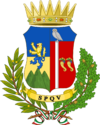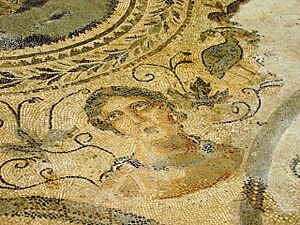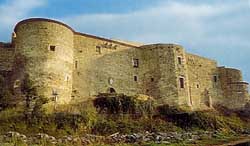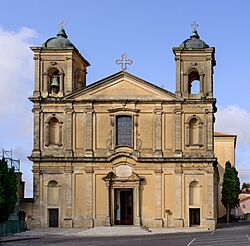Vibo Valentia facts for kids
Quick facts for kids
Vibo Valentia
|
|||
|---|---|---|---|

Panorama of Vibo Valentia
|
|||
|
|||
| Country | Italy | ||
| Region | Calabria | ||
| Province | Vibo Valentia (VV) | ||
| Frazioni | Bivona, Longobardi, Piscopio, Porto Salvo, San Pietro, Vena Inferiore, Vena Media, Vena Superiore, Triparni, Vibo Marina | ||
| Area | |||
| • Total | 46.2 km2 (17.8 sq mi) | ||
| Elevation | 476 m (1,562 ft) | ||
| Time zone | UTC+1 (CET) | ||
| • Summer (DST) | UTC+2 (CEST) | ||
| Postal code |
89900, 89811
|
||
| Dialing code | 0963 | ||
Vibo Valentia is a cool city in the Italian region of Calabria. It's located close to the Tyrrhenian Sea. This city is the main town of the province of Vibo Valentia.
Vibo Valentia is an important place for farming, business, and tourism. Some famous spots nearby include Tropea, Ricadi, and Pizzo. The city also has big factories, like those that process tuna in Maierato. The harbor at Vibo Marina is super important for the local economy.
Contents
Discovering Vibo Valentia's Past
How Vibo Valentia Began
Vibo Valentia started as an ancient Greek colony called Hipponion. People from Locri, a big city on the Ionian Sea, founded it around the late 7th century BC. The city had huge walls, about 7 kilometers long. You can still see parts of these walls today. They were very tall and strong, showing how rich the city was and how many wars it fought.
Roman Times and New Names
In 388 BC, a ruler named Dionysius the Elder took over the city. He made everyone leave. But in 378 BC, with help from the Carthaginians, the people came back. Later, Hipponion was ruled by the Bruttii. When the town became part of Rome, its name changed to Hipponium.
In 194 BC, it became a Roman colony and was called Vibo Valentia. The city did very well during the Roman Republic and early Empire. Even a famous Roman, Cicero, had a house here. After the Western Roman Empire fell, the town was almost empty.
The Castle and Monteleone
Around 1070, the Normans built a castle where the old Greek city used to be. They even used stones from nearby Greek temples to build it. In 1235, a new city was created by Frederick II. He was the Holy Roman Emperor and King of Sicily. He named the new city Monteleone. The city finally got its old Roman name, Vibo Valentia, back in 1928.
Exploring Vibo Valentia's Landmarks
Famous Buildings and Structures
- Norman-Hohenstaufen Castle: This castle was built around the year 1000. It stands where the ancient Greek city's main area once was. The castle was damaged by an earthquake in 1783. Today, it's a state museum where you can learn about the area's history.
- Walls of Hipponion: You can still see about 350 meters of these ancient Greek walls. They also have the foundations of eight towers, which were probably about 10 meters tall.
- Church of Santa Maria Maggiore e San Leoluca: This church, also known as the Cathedral, was built in the 9th century. It stands on top of an old Byzantine church. Inside, you'll find an 18th-century marble altar and a 16th-century sculpture.
- Santa Ruba Church: Built around the year 1000, this church has a large dome that looks like it's from the Middle East. It's located between Vibo Valentia and San Gregorio d'Ippona.
- Church of the Rosario: This church was built around 1337 over an old Roman temple. It was rebuilt after the 1783 earthquake. It has paintings by Giulio Rubino and wooden statues used in Holy Week parades.
- Church of Carmine: Built in the 17th century, this church has an oval shape. Its old convent was used as a city hospital for a long time.
- Church of Santa Maria degli Angeli: Built between 1621 and 1666, this church has a wooden cross from the 1600s. Many people visit it every March.
- Church of Saint Michael: Inside this church, you can see paintings by famous artists like Luca Giordano and Ludovico Mazzanti.
- Church of Saint Joseph: Opened in 1701, this church has several paintings and wooden sculptures, including one of Saint Joseph on the main altar.
- Church of the Holy Spirit: Built in 1579, this was the city's first church. It's not used as a church anymore, but it used to hold many artworks.
- Church of Santa Maria la Nova: Built in 1521, this church holds the tomb of Duke Ettore Pignatelli. It was once used as a stable and armory. It has many works by the Flemish painter Dirk Hendricksz.
- Church of Santa Maria del Soccorso: Built around 1632, this church was rebuilt in 1791.
- La Madonnella: This is a small church built where an old Capuchin convent used to be.
- Church of Saint Anthony of Padua: Built in the 17th century, this church has paintings by Luca Giordano and Pacecco De Rosa.
Sister Cities Around the World
Vibo Valentia has special connections with other cities, called "twin towns" or "sister cities."
 Corleone, Palermo, Sicily, Italy
Corleone, Palermo, Sicily, Italy Ruda Śląska, Poland
Ruda Śląska, Poland Vrnjačka Banja, Serbia
Vrnjačka Banja, Serbia Ituzaingó, Argentina
Ituzaingó, Argentina
See also
 In Spanish: Vibo Valentia para niños
In Spanish: Vibo Valentia para niños







